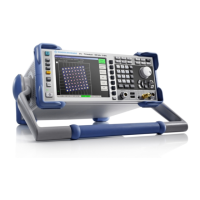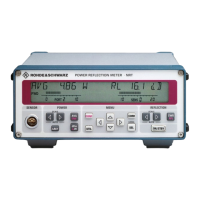R&S FSH Two-port measurements with the tracking generator
1309.6275.12 4.45 E-2
Displaying the occupied bandwidth
T
he R&S FSH now displays the occupied bandwidth (OBW: nnn.nn MHz) above the measurement
diagram.
Changing the span
The span set by the R&S FSH normally yields optimum measurement results. In some cases, however,
a larger span needs to be selected. This is the case, for example, when the area outside the span that
is automatically set contains signal components that need to be included in the measurement.
Operation:
Press the SPAN key.
The AUTO SPAN softkey label is highlighted in green
to indicate that the optimum span for measuring the
occupied bandwidth is set. MANUAL SPAN entry is
active for immediate entry of another span.
Using the numeric keys, enter a new span and
terminate the entry with the appropriate unit, or
Change the span with the rotary knob or the cursor
keys and terminate the entry with the ENTER key
or the MANUAL SPAN softkey.
The largest permissible span for measuring the occupied bandwidth is ten times the channel bandwidth.
At larger spans, the result of the channel power measurement would be increasingly imprecise,
because too few points of the trace occur in the channel to be measured.
Press the AUTO SPAN softkey to again set the optimum span.
To return to the menu for measuring the occupied bandwidth, press the MEAS key.
Two-port measurements with the tracking generator
Only for R&S FSH with tracking generator (order number 1309.6000.14, 1309.6000.24, 1309.6000.18
or 1309.6000.28).
The R&S FSH can be supplied with an optional tracking generator to measure the transmission of two-
ports or the reflection coefficients of one-ports and two-ports. The tracking generator outputs a signal at
the current R&S FSH frequency. The nominal output level can be selected from 0 dBm to -50 dBm in 1
dB steps.
Two-port transmission can be determined directly by connecting the input of the DUT to the output of
the tracking generator and the DUT’s output to the R&S FSH’s RF input. A bridge is required to
measure the reflection coefficient, as included in the R&S FSH4 model, catalogue number
1309.6000.24 and the R&S FSH8, catalogue number 1309.6000.28. With current VSWR measuring
bridges, the R&S FSH can carry out measurements in both the forward and backward directions. A two-
port measurement object can thus be measured for impedance at the input and at the output and for the
transmission in both directions.
Due to the calibration technique used, the R&S FSH’s measurement accuracy is high for both
transmission measurements and reflection measurements. The R&S FSH offers scalar calibration
methods as standard; i.e. with transmission and reflection measurements, the magnitudes are
corrected. Vector calibration methods and measurements (option R&S FSH-K42) are possible for

